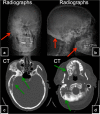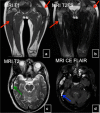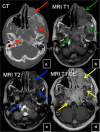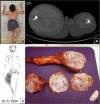Fibrous dysplasia for radiologists: beyond ground glass bone matrix
- PMID: 30484079
- PMCID: PMC6269335
- DOI: 10.1007/s13244-018-0666-6
Fibrous dysplasia for radiologists: beyond ground glass bone matrix
Abstract
Fibrous dysplasia (FD) is a congenital disorder arising from sporadic mutation of the α-subunit of the Gs stimulatory protein. Osseous changes are characterised by the replacement and distortion of normal bone with poorly organised, structurally unsound, fibrous tissue. The disease process may be localised to a single or multiple bones. In McCune-Albright syndrome (MAS), fibrous dysplasia is associated with hyperfunction of endocrine organs and overproduction of melanin in the skin, while Mazabraud syndrome FD is associated with intramuscular myxomas. In radiology, FD is very often automatically associated with the term "ground glass matrix". However, FD is a complex disease, and knowledge of its unique pathogenesis and course are crucial to understanding imaging findings and potential complications. This article aims to not only summarise the spectrum of radiological findings of osseous and extra-osseous abnormalities associated with FD but also to highlight the pathological base of the disease evolution, corresponding imaging changes and complications based on the disease distribution. We also have provided current recommendations for clinical management and follow-up of patients with FD. TEACHING POINTS: • FD is often a part of complex disease, involving not only bone but also multiple other organs. • FD lesions are characterised by age-related histological, radiographical and clinical transformations. • Radiologists play a crucial role in the identification of osseous complications associated with FD. • The craniofacial form of the disease is the most common type of FD and the most difficult form to manage. • Patients with McCune-Albright syndrome may have different extra-skeletal abnormalities, which often require follow-up.
Keywords: Fibrous dysplasia; Ground glass bone matrix; Mazabraud’s syndrome; McCune-Albright syndrome; Skeletal radiology.
Figures






























Similar articles
-
Incidental Intercostal Intramuscular Myxoma With Fibrous Dysplasia in a Patient With Mazabraud's and McCune Albright Syndromes.Cureus. 2022 Mar 5;14(3):e22869. doi: 10.7759/cureus.22869. eCollection 2022 Mar. Cureus. 2022. PMID: 35265436 Free PMC article.
-
Craniofacial Fibrous Dysplasia: Clinical and Therapeutic Implications.Curr Osteoporos Rep. 2023 Apr;21(2):147-153. doi: 10.1007/s11914-023-00779-6. Epub 2023 Feb 28. Curr Osteoporos Rep. 2023. PMID: 36849642 Free PMC article. Review.
-
Mazabraud Syndrome Associated with McCune-Albright Syndrome: A Case Report and Literature Review.Case Rep Oncol. 2023 May 12;16(1):294-301. doi: 10.1159/000529731. eCollection 2023 Jan-Dec. Case Rep Oncol. 2023. Retraction in: Case Rep Oncol. 2023 Nov 24;16(1):1489. doi: 10.1159/000535134. PMID: 37187684 Retracted.
-
McCune-Albright syndrome with craniofacial dysplasia: Clinical review and surgical management.Surg Neurol Int. 2016 Mar 11;7(Suppl 6):S165-9. doi: 10.4103/2152-7806.178567. eCollection 2016. Surg Neurol Int. 2016. PMID: 27057395 Free PMC article.
-
Advances in Models of Fibrous Dysplasia/McCune-Albright Syndrome.Front Endocrinol (Lausanne). 2020 Jan 24;10:925. doi: 10.3389/fendo.2019.00925. eCollection 2019. Front Endocrinol (Lausanne). 2020. PMID: 32038487 Free PMC article. Review.
Cited by
-
Iatrogenic muscle damage in transforaminal lumbar interbody fusion and adjacent segment degeneration: a comparative finite element analysis of open and minimally invasive surgeries.Eur Spine J. 2021 Sep;30(9):2622-2630. doi: 10.1007/s00586-021-06909-x. Epub 2021 Jul 14. Eur Spine J. 2021. PMID: 34259908
-
Comparison of MRI Findings among Osteofibrous Dysplasia, Fibrous Dysplasia, and NonOssifying Fibroma of the Long Bone.Indian J Radiol Imaging. 2023 Jan 13;33(2):150-156. doi: 10.1055/s-0042-1760363. eCollection 2023 Apr. Indian J Radiol Imaging. 2023. PMID: 37123588 Free PMC article.
-
Surgical Management of a Case of Frontoparietal Fibrous Dysplasia.Cureus. 2025 Jul 18;17(7):e88246. doi: 10.7759/cureus.88246. eCollection 2025 Jul. Cureus. 2025. PMID: 40831852 Free PMC article.
-
McCune Albright syndrome: an endocrine medley.BMJ Case Rep. 2019 Jul 15;12(7):e229141. doi: 10.1136/bcr-2018-229141. BMJ Case Rep. 2019. PMID: 31308184 Free PMC article.
-
Long Bone Fractures in Fibrous Dysplasia/McCune-Albright Syndrome: Prevalence, Natural History, and Risk Factors.J Bone Miner Res. 2022 Feb;37(2):236-243. doi: 10.1002/jbmr.4463. Epub 2021 Nov 17. J Bone Miner Res. 2022. PMID: 34668234 Free PMC article.
References
-
- Kozlowski K, Beighton P. Gamut index of skeletal dysplasias: an aid to radiodiagnosis. London: Springer; 2012.
Publication types
LinkOut - more resources
Full Text Sources

